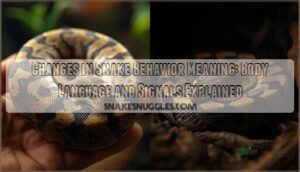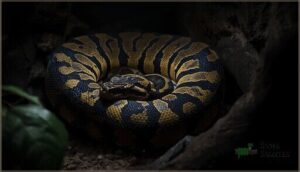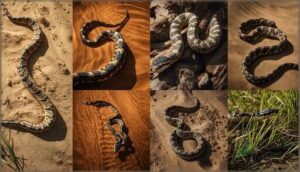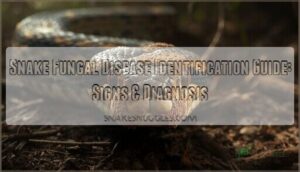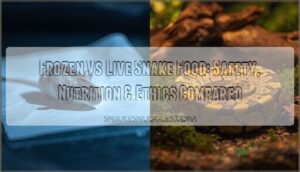This site is supported by our readers. We may earn a commission, at no cost to you, if you purchase through links.
Your snake suddenly stops eating. It coils tight in the corner and won’t come out. These aren’t random quirks. They’re signals written in a language most people never learn to read.
Snakes telegraph their internal state through posture, movement, and breathing patterns. A calm snake drapes loosely across your hand. A stressed one holds rigid with muscle tension visible along its body.
Understanding these shifts helps you distinguish a defensive warning from simple exploration. It separates illness from temperament. When you can decode what your snake is telling you, you stop guessing and start responding to its actual needs.
Table Of Contents
Key Takeaways
- Snakes communicate stress, illness, and mood through body posture, movement speed, and breathing patterns—relaxed snakes drape loosely while stressed ones hold rigid with visible muscle tension.
- Defensive behaviors escalate in a predictable sequence: most snakes flee first, then display warning signals like tail vibration or hissing, and only strike as a last resort when cornered.
- Environmental factors like temperature changes, habitat loss, and human encroachment directly alter snake activity levels, stress hormones, and defensive behavior—warm weather triggers earlier emergence while urban development increases conflict incidents by 38%.
- Changes in normal movement patterns, feeding habits, or hiding behavior serve as reliable health indicators—sick or stressed snakes show lethargy, refuse food, move erratically, or exhibit incomplete shedding.
Key Snake Behaviors and Their Meanings
Snakes can’t tell you what they’re feeling, but their bodies speak loud and clear. Learning to read their movements and postures helps you understand what’s going on under those scales.
Here’s what to watch for when observing your snake’s behavior.
Common Snake Body Language Cues
Snakes speak through their bodies. You can learn their language by watching a few key signals. Relaxed postures show loose muscles and slow movement.
Investigative cues include steady tongue flicking as your snake samples its environment. Defensive postures involve coiling and head elevation. Locomotion changes signal shifting moods. Visual displays of skin patterns complete this silent vocabulary of snake communication.
Stressed snakes, however, may exhibit frantic and rapid movement.
Signs of Stress or Discomfort
When stress levels rise, your snake’s body tells the story. Watch for hiding behavior that increases during disturbance. Elevated corticosterone shows up as muscle wasting and feeding refusal lasting weeks. Social buffering from companions can reduce stress responses.
Recognizing abnormal behavior matters for snake wellbeing. A sick snake may exhibit signs of lethargy. Look for muscle tension, rapid breathing, or neurological problems.
Defensive strikes become more likely when stress hormones stay high.
Aggressive and Defensive Postures
Beyond stress signals, you’ll notice defensive postures when a snake feels threatened. These snake defense mechanisms vary by species but share common patterns in snake body language.
Key aggressive behavior and defensive behavior signs:
- Hooding displays where cobras raise 13–22% of their body length
- Tail vibration increasing from 40 Hz to 60–100 Hz as threats approach (distance signaling)
- Bluff strikes that miss intentionally—about 25% never make contact
- Body raising preceding 77% of strikes in brownsnakes
- Strike kinematics showing defensive strikes launch from three times farther than feeding strikes
Understanding these defensive postures helps you respond safely.
Abnormal Vs. Normal Behavior Patterns
Recognizing abnormal behavior starts with understanding snake behavior patterns. Normal snakes rest about 58% of the time and explore periodically.
Watch for stereotypic behavior signs like glass surfing or repetitive nose rubbing—these appear in over 52% of captive snake stress cases.
Health-behavior correlation matters too. Shedding problems and respiratory issues often accompany unusual activity. Common snake behaviors shift when environmental impact or illness disrupts their routine, making snake health indicators visible through movement changes.
Snake Communication Methods Explained
Snakes don’t make sounds like other animals do. Instead, they use body movements, chemical signals, and a few distinct sounds to send messages to their surroundings.
Understanding these methods helps you read what a snake is trying to tell you.
Tongue Flicking and Chemical Sensing
When you see a snake flicking its tongue, you’re watching one of nature’s most precise chemical sensors at work. Flicking frequency can reach six or seven times in under a second. Each forked tip collects different chemical signals and delivers them to the VNO for processing.
A snake’s flickering tongue samples the air up to seven times per second, delivering chemical signals to its sensory organ with striking precision
This sensory input helps snakes track prey, detect mates through pheromones, and assess environmental threats with striking accuracy.
Tail Vibrations and Warning Signals
When a snake rapidly shakes its tail, you’re witnessing one of the most effective warning signals in nature. This behavior has multiple defensive purposes:
- Vibration mimicry – Nonvenomous snakes imitate rattlesnakes to deter predators through behavioral cues
- Frequency variation – Rates range from 9 to 91 vibrations per second depending on species and temperature
- Muscle specialization – Rattlesnakes possess uniquely adapted tail muscles supporting sustained high-speed movements
- Signal effectiveness – Predator response studies show animals adjust threat assessment based on tail movement intensity
These body language displays increase with perceived danger, making them reliable indicators of a snake’s defensive state.
Hissing and Audible Threat Displays
You’ll hear hissing when a snake feels threatened. This audible warning spans frequencies from 40 Hz to 12,000 Hz, depending on species variation. Vipers produce low-frequency sounds at 200–400 Hz, while grass snakes hiss higher at 5,000–10,000 Hz.
Defensive postures like neck flattening often accompany hissing. This snake communication requires metabolic cost, increasing energy use by 25% during defensive behavior against predators.
Pheromone Use in Social and Mating Contexts
Chemical signals drive mating rituals more than visual cues. Males follow pheromone trails from females with near-perfect accuracy, using tongue flicks to detect long-chain ketones in skin secretions. This pheromone communication helps locate mates during brief breeding windows.
Social aggregation at dens also relies on chemical markers. The vomeronasal system processes these reproductive signals, allowing males to assess female size and readiness through pheromone detection alone.
Environmental Factors Influencing Behavior
Snakes don’t exist in a vacuum. Their behavior shifts in response to the world around them—temperature swings, habitat loss, and even the encroachment of human activity.
Let’s look at the key environmental factors that shape how snakes act and survive.
Temperature and Seasonal Changes
When temperatures hit around 15.5°C in spring, you’ll see snakes emerge from brumation and begin their active season. Snake behavior shifts dramatically with seasonal changes as these animals rely on environmental conditions to regulate activity levels.
Warmer years advance Emergence Timing and Breeding Shifts by weeks. Thermal Adaptation allows snakes to adjust Activity Peaks throughout the year, with Brumation Length shortening as climates warm.
Habitat Alterations and Human Encroachment
When you build roads or expand cities into wild spaces, you force snakes into tighter areas. Urban snake diets contain 33% fewer prey types and meals shrink by 15%.
Habitat loss drives retreat-site fidelity up by 15% as snakes cling to scarce shelter. Conflict incidents rise 38% in developed zones.
Stress hormone levels spike 70% higher under these environmental conditions, triggering more defensive strikes and behavioral diversity shifts.
Climate Change and Range Shifts
Warming climate change drives snakes to shift their ranges. Up to 68% of species face altered distributions by century’s end. You’ll see range expansion in some snakes and habitat contraction in others.
Altitudinal migration pushes species upward into cooler zones. Hotspot turnover reshapes where snakes concentrate. Biophysical constraints limit how fast they adapt.
These environmental factors force behavioral changes you need to recognize.
Impact on Activity and Survival Strategies
These range changes force snakes to alter their survival strategies. Active foragers maintain metabolic rates 40% higher than ambush hunters to support increased movement. You’ll notice seasonal activity peaks during wet months when snake encounters jump. Climate resilience depends on foraging adaptations and behavioral flexibility.
Habitat disturbance and pollution effects further stress populations, making snake body language interpretation essential for recognizing struggling individuals under shifting environmental conditions.
- Active hunting requires higher energy than sit-and-wait strategies
- Wet season triggers peak above-ground activity levels
- Temperature increases of 1°C raise bite risk by 5.6%
- Human habitat changes alter snake movement patterns
Changes in Snake Movement and Locomotion
Snakes don’t move the same way all the time. Their locomotion changes based on terrain, threat level, and physical condition.
Understanding these shifts helps you read what your snake is experiencing and whether something might be wrong.
Adaptive Movement Techniques
Snakes rely on adaptive locomotion to navigate different environments and signal their state. Center-lifting locomotion helps them cross gaps and uneven ground. Serpentine motion remains their primary technique on flat surfaces. In confined spaces, they switch to concertina movement. Fossorial locomotion lets burrowing species move underground efficiently.
Translocation effects show altered movement patterns when snakes encounter unfamiliar territory. These snake behavior patterns reveal stress levels and environmental challenges.
Arboreal, Aquatic, and Gliding Behaviors
Beyond ground-level movement, some species climb trees while others have mastered water or even air. You’ll notice arboreal locomotion in tree-dwelling snakes with keeled scales for grip. Aquatic adaptations like paddle tails power swimming in marine species. Gliding mechanics let paradise tree snakes flatten their bodies and undulate through air, covering distances up to 10 meters or 13 degrees from horizontal.
Key specialized snake locomotion patterns:
- Arboreal snakes switch between concertina and lateral undulation based on branch angle and surface texture
- Sea snakes breathe through their skin for up to 30% of oxygen needs during dives
- Gliding snakes use S-shaped body waves to control trajectory and boost flight distance
- Environmental factors like humidity and temperature drive tree-climbing frequency in otherwise ground-dwelling species
Defensive Movements During Threats
When threatened, you’ll see snake behavior shift through a behavioral hierarchy based on context dependence. Most snakes choose fleeing behavior first—68% escape immediately. If cornered, defensive postures escalate: tail vibration, body thrashing, and S-start motions appear before strikes. Aggressive behavior emerges last.
Strike velocity increases during defense compared to hunting, while posture dynamics reflect threat intensity and body language signals shifting survival priorities through snake communication.
Locomotion as a Sign of Health or Stress
When you notice your snake moving differently, you’re seeing an important health indicator. Healthy snakes spend about 15% of their time actively locomoting.
Stress-induced movement appears as erratic patterns or hyperactivity—translocated snakes show twice the surface movement of residents. Watch for abnormal locomotion like repetitive pacing.
Muscle coordination drops 40% in snakes with musculoskeletal disorders, making adaptive locomotion impossible.
Behavioral Shifts During Feeding and Reproduction
Snakes change their behavior dramatically when they’re feeding or preparing to reproduce. You’ll see shifts in activity patterns, appetite, and even temperament during these critical life stages.
Recognizing these changes helps you understand what your snake needs and when to give it space.
Mating Rituals and Courtship Displays
When spring arrives, male snakes begin courtship by chin-rubbing and tail-looping around females. Pheromone signaling attracts males from over a kilometer away. You’ll see courtship combat between males wrestling for access to receptive females.
Mating systems vary, but copulation duration can stretch from one hour to nearly a full day. Post-mating behavior shows males leaving immediately while females store sperm for years.
Changes in Feeding Habits and Patterns
Snake feeding habits change dramatically with the seasons. You’ll notice snakes eating five times more in summer than spring, with dietary shifts from lizards in cool months to mammals in warmer periods.
Climate influence extends active feeding seasons, letting snakes grow larger. After long fasting periods, some pythons consume prey weighing 25% of their body mass in one meal—a dietary adaptation that shows how prey selection and seasonal consumption patterns maximize survival.
Shedding and Associated Behavioral Changes
During ecdysis, your snake’s behavior patterns shift dramatically. The snake shedding process demands energy expenditure equal to 3% of its annual metabolic budget, triggering noticeable changes you should recognize:
- Cryptic behavior and reduced foraging – Snakes hide for up to 28 days and stop eating during preshedding phases
- Shedding stress signs – Clouded eye caps impair vision, increasing defensive aggression
- Recovery period – Activity normalizes once shedding completes successfully
Parental and Social Behaviors During Breeding
Most snakes abandon their eggs, but some mothers defy expectations. Southern African python females protect their clutch of 40 to 50 hatchlings for two weeks in underground burrows. Maternal attendance includes temperature regulation above 82°F to prevent deformities.
Communal nesting occurs in species like Philothamnus angolensis, where up to 85 eggs share one site. Offspring clustering helps garter snake neonates survive together during mating season.
Frequently Asked Questions (FAQs)
How do snakes respond to artificial lighting?
Bright city lights can slash nocturnal activity by 40%. You’ll see snakes avoiding lit areas and shifting their hunting schedules.
Circadian disruption throws off their internal clocks, and defensive responses increase under constant artificial lighting.
Can snakes recognize individual humans over time?
No verified evidence shows snakes recognize individual humans visually. Their visual acuity targets motion and prey detection.
Habituation effects may reduce stress through scent cues and behavioral conditioning, not true human recognition.
Do snakes exhibit play behavior in captivity?
While enrichment and cognition improve in captive environments, documented play behavior remains virtually absent in snakes.
Stereotypies vs. play distinctions reveal that repetitive movements reflect stress rather than genuine reptile play comparison researchers seek.
How does injury alter a snakes behavior?
Injury greatly impacts snake behavior through reduced locomotion performance and elevated stress hormone levels. You’ll notice increased defensive strike rates, social avoidance, and altered feeding adaptations.
These changes reflect compromised snake health and neurological problems affecting normal animal behavior.
What behaviors indicate snake aging or illness?
Lethargy signs include prolonged hiding and reduced activity. Feeding decline shows as refusal to eat and weight loss. Shedding issues appear as incomplete skin removal. Movement changes reveal poor coordination or weakness indicating neurological problems.
Conclusion
A wild snake flees when threatened. A captive snake with nowhere to go freezes or strikes. That difference matters.
Changes in snake behavior meaning become clear once you factor in context, environment, and individual history. You’re not just watching a reptile move. You’re reading stress levels, health status, and emotional state.
Master this skill and you’ll anticipate problems before they escalate. Your snake’s body language stops being cryptic and starts being a conversation you can actually follow.
- https://pmc.ncbi.nlm.nih.gov/articles/PMC10884060/
- https://www.nationalgeographic.com/animals/article/snakes-social-behavior
- https://www.yahoo.com/news/articles/researchers-issue-warning-observing-concerning-031500910.html
- https://onlinelibrary.wiley.com/doi/full/10.1002/ece3.10305
- https://journal-of-herpetology.kglmeridian.com/view/journals/hpet/55/1/article-p77.xml

